Original|Odaily Planet Daily (@OdailyChina)

On July 30, 2025, Ethereum celebrates its tenth anniversary. For a blockchain network that has been running continuously for 10 years, this is indeed a miracle—just as Ethereum founder Vitalik mentioned in a previous post: “Ethereum has been online for ten years without any pauses or maintenance. Meanwhile—Facebook once went down for 14 hours, Cloudflare lost 19 data centers, and other Layer 1 networks have faced multiple issues, but Ethereum never stops. Every centralized giant will experience downtime because they rely on staff and scheduled maintenance. Whether it’s forks, crashes, bubbles, lawsuits, hacks, wars, or various dramatic events that the internet may trigger. Despite bank failures and server repairs, Ethereum continues to operate. Developers, stakers, researchers, and users from around the world have been active between the blocks year after year, and it is we who have collectively created this grand scene.” Just like the protagonist in an inspirational novel who perseveres through countless difficulties, Ethereum, having reached its 10th anniversary, deserves the phrase—“What does not kill me makes me stronger.”
Looking back over the past 10 years, Ethereum truly resembles a once-unknown poor boy who has now entered the hall and become an indispensable “guest” in Wall Street and the global economic system. From a white paper with the ambition to “surpass the Bitcoin network” to a highly anticipated ICO; from the roaring DeFi Summer to the shift to POS; from the crypto winter to the spot ETF, Ethereum's 10 years have not always been filled with glory and honor, but also crises and shame. Fortunately, with the narrative of the “ETH reserve treasury” reignited, Ethereum has once again returned to the center stage of the crypto world.
Perhaps you are tired of the clichéd and rigid retrospectives of historical events, or perhaps not many people care about the trivialities in Ethereum's development process. Perhaps the most pressing question now is—How many rounds of “big players” have changed in Ethereum over the past 10 years? Who is still at the table? What is the price ceiling for ETH?
Odaily Planet Daily will provide its answers in this article, inviting readers to share in the discussion.
Ethereum Never Sleeps: From an ICO Price of Less Than $0.3 to the Wall Street Craze for Spot ETFs
Undoubtedly, Ethereum's victory was initially a celebration for the entire industry. Although the industry was still in its primitive stage at that time, the crypto market had already shown a pattern of many heroes rising: BTC was dominant, LTC was on the rise, and DOGE was beginning to shine, with new coins appearing every moment, only to disappear like sand and gravel in the river of history. It was against this backdrop of coexisting crises that Ethereum emerged.
The First Batch of Big Players in ETH: ICO Participants and Early Contributors
From July 22 to September 2, 2014, lasting about 42 days, the Ethereum ICO successfully concluded. In the first two weeks, the ratio was set at 1 ETH: 0.0005 BTC (i.e., 2000 ETH = 1 BTC, with BTC prices ranging from $572 to $632), and then it linearly decreased to 1 ETH: 0.0007479 BTC (i.e., 1337 ETH = 1 BTC, with BTC prices ranging from $471 to $592), raising a total of about $18 million.
Calculating based on the different BTC prices at that time, the ICO price for a single ETH was as low as about $0.286; the current mainstream market data of $0.3-$0.31 for the ICO price corresponds to $18.3 million based on a total of 60 million ETH. Of course, this also highlights the early industry's lack of a unified measurement standard. Although BTC prices were unstable at that time, it was still an undisputed hard currency.

Ethereum team, Toronto, 2014 by Duncan Rawlinson/Flickr Creative Commons
On July 30, 2015, about a year later, Ethereum officially launched. According to official historical records, an initial total of 72 million ETH was pre-mined, of which 60 million were allocated to ICO participants, and over 12 million were allocated to early contributors and the Ethereum Foundation. For instance, Vitalik reportedly received 553,000 ETH for his personal contributions; other known early contributors include Cardano founder Charles Hoskinson, Bitcoin Magazine founder Mihai Alisie, Decentral founder Anthony Di Iorio, Amir Chetrit, Polkadot founder Gavin Wood, Grit Games founder Jeffrey Wilcke, and Consensys founder Joseph Lubin, each reportedly receiving 300,000 ETH. Additionally, the Ethereum Foundation retained 3 million ETH for operational purposes and conducted two large-scale sales at market peaks in 2018 and 2021.
Currently, the Ethereum Foundation's main wallet address** still holds 185,000 ETH, valued at about $720 million;** Vitalik's related address** still holds 240,000 ETH, valued at about $928 million.**
It is worth mentioning that there are many whales in the ICO holding hundreds of thousands or even millions of ETH, which has also been a focal point of criticism for Ethereum in its early days—over-centralization of early token distribution.
According to a Galaxy report, among the 8,800 participating addresses in the ETH ICO, about 100 addresses received 40% of the ETH ICO share. Additionally, on-chain information shows that the address cluster that received 1 million ETH ultimately points to the ENS domain virternity.eth; the other two ICO whales received 935,900 ETH and 933,580 ETH, respectively. Data shows that from 2015 to 2018, about 10.3 million ETH (accounting for 41.7% of the pre-mined supply) flowed into CEX; in contrast, only 1.6 million ETH (about 2.3% of the pre-mined supply) remained unchanged during the same period. In other words, many Ethereum ICO participants had already taken profits within the first three years.
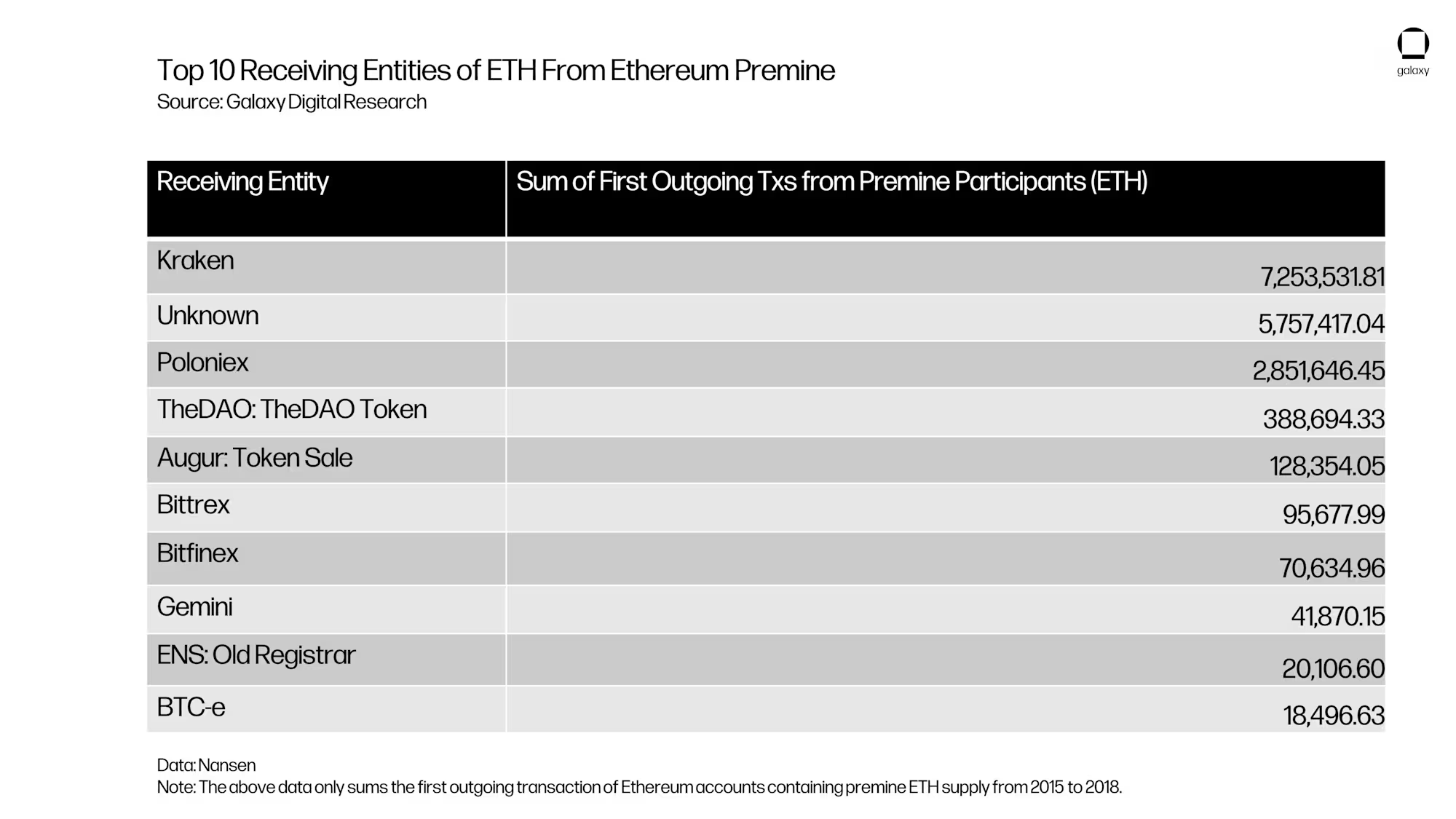
Nansen data, source: Galaxy research report
The Second Batch of Big Players in ETH: Ethereum Miners and Crypto Institutions
After the ICO concluded and early ETH holders divided the spoils, the second batch of big players emerged: Ethereum miners and various crypto capital.
In 2015, after the Ethereum network went live, it operated using a proof-of-work (PoW) mechanism similar to the Bitcoin network, where miners earned newly issued ETH tokens by verifying transactions and securing the network. From 2015 until the POS upgrade in 2022, approximately 49.1 million ETH were produced through mining, gradually diluting the initial pre-mined holdings.
According to YCharts data, the cumulative number of unique ETH holding addresses grew from a few thousand in 2015 to 170 million by September 2022; meanwhile, Ethereum's mining rewards decreased from 5 ETH per block in 2015; by the end of 2017, the block reward dropped to 3 ETH; and by early 2019, it further decreased to 2 ETH, which further impacted the distribution pattern of ETH holdings.
It is noteworthy that throughout Ethereum's mining history, there has always been a test of consensus at the community level, particularly highlighted by the intense hard fork resulting from the “The DAO hack incident” in 2016. At that time, the hack caused losses of up to 3.6 million ETH, valued at about $60 million. After weeks of discussions and debates, on July 20 of that year, ETC was born, and ETH was reborn.
Subsequently, despite the difficulties, the lower mining difficulty still encouraged many to participate in the booming Ethereum mining wave, with some internet café owners even using idle equipment to mine and accumulate tens of thousands of ETH. Such a rare opportunity for wealth creation naturally led to the emergence of a new class of wealthy individuals. Among those still active in the market are F2Pool, Cobo founder Shen Yu, Wanxiang Group chairman, and Hashkey founder Xiao Feng, who are also participants in this era's wave and can even be considered true trendsetters. The former started with Bitcoin mining and also participated in early Ethereum mining, becoming well-known in the industry as the “ETH whale”; the latter once spent $500,000 to save Ethereum during an early visit to China by Ethereum founder Vitalik, laying the foundation for Ethereum's early development in the Chinese-speaking regions.

In October 2019, Dragonfly hosted a crypto summit, featuring Dragonfly founder Feng Bo, Meituan CEO Wang Xing, Vitalik, and Wanxiang's Xiao Feng.
As time progressed, the Ethereum ecosystem welcomed another wave of new forces—the expansion of DeFi protocols.
Starting in 2020, DeFi protocols, which focused on the concept of “liquidity mining,” experienced explosive growth, with a large amount of ETH being locked as liquidity in various smart contracts. According to Coindesk statistics, as of July 29, 2020, $3.68 billion worth of crypto assets were locked in various DeFi protocols. By May 2021, according to Galaxy analysis, this number rapidly increased to over 31.2 million ETH (approximately 26% of the total ETH supply at that time), valued at about $57.4 billion.
Of course, there was also a milestone event during this transformation—the POS upgrade. In September 2022, Ethereum completed The Merge upgrade, successfully transitioning the entire network from a PoW mechanism to a PoS mechanism. Since then, the identity of Ethereum miners has gradually become a thing of the past, replaced by “large stakers of ETH”—including exchanges, crypto institutions, as well as whales and individuals.
As early participants in the Ethereum ecosystem, crypto capital from institutions such as Galaxy, Paradigm, Dragonfly, and Hashkey were undoubtedly the big players during this phase, and they can only be replaced by larger-scale capital.
The Third Batch of Big Players in ETH: Wall Street Capital and Spot ETFs
In July 2024, following the approval of Bitcoin spot ETFs in January of that year, the U.S. SEC approved multiple Ethereum spot ETFs (including BlackRock, Fidelity, Grayscale, 21 Shares, Franklin Templeton, Bitwise, etc.). Thus, ETH began its third wave of “changing hands,” with the new “buyers” no longer limited to the cryptocurrency circle but coming from Wall Street financial institutions and professional investors active in global capital markets.
The reason why Wall Street financial institutions have become the “ETH big players” in today's market is mainly twofold:
First, the Ethereum spot ETF market has performed remarkably well. According to Sosovalue data, as of July 28, the total net asset value of Ethereum spot ETFs was $21.534 billion, with an ETF net asset ratio (market value compared to total Ethereum market value) reaching 4.71%. The historical cumulative net inflow has reached $9.4 billion. Among them, BlackRock's iShares Ethereum ETF (ETHA) performed astonishingly: just 251 days after its launch, its asset scale had surpassed $10 billion, becoming the third-fastest ETF to reach this scale in history. Meanwhile, in the past month, the net amount of ETH held in global exchanges has decreased by over 1 million (approximately $3.8 billion), with a large amount of ETH likely flowing out of exchanges into the custody of ETF issuers, cold wallets, or being used to support institutional investment demand.
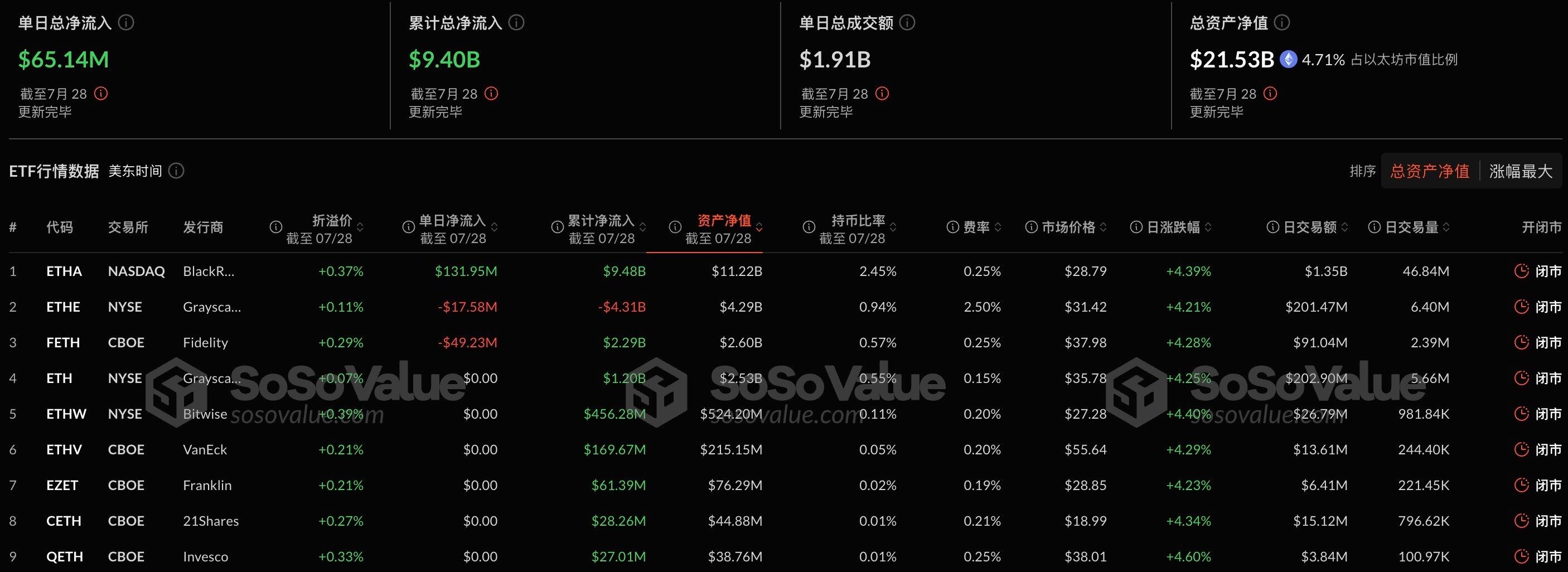
ETH spot ETF data, as of July 28.
Second, the “ETH reserve treasury” narrative has been highly favored by the U.S. stock market. According to data from Strategicetheserve, the total holding of listed companies establishing ETH reserve treasuries has exceeded 2.329 million ETH, valued at $9.02 billion. Companies like Bitmine, Sharplink, The Ether Machine, and The Bit Digital are still continuously increasing their ETH holdings, with the first two's ETH holdings even far exceeding that of the Ethereum Foundation. As a result, new capital buying has helped ETH prices gradually recover, rebounding from around $2,400 to now above $3,800, previously nearing $4,000.
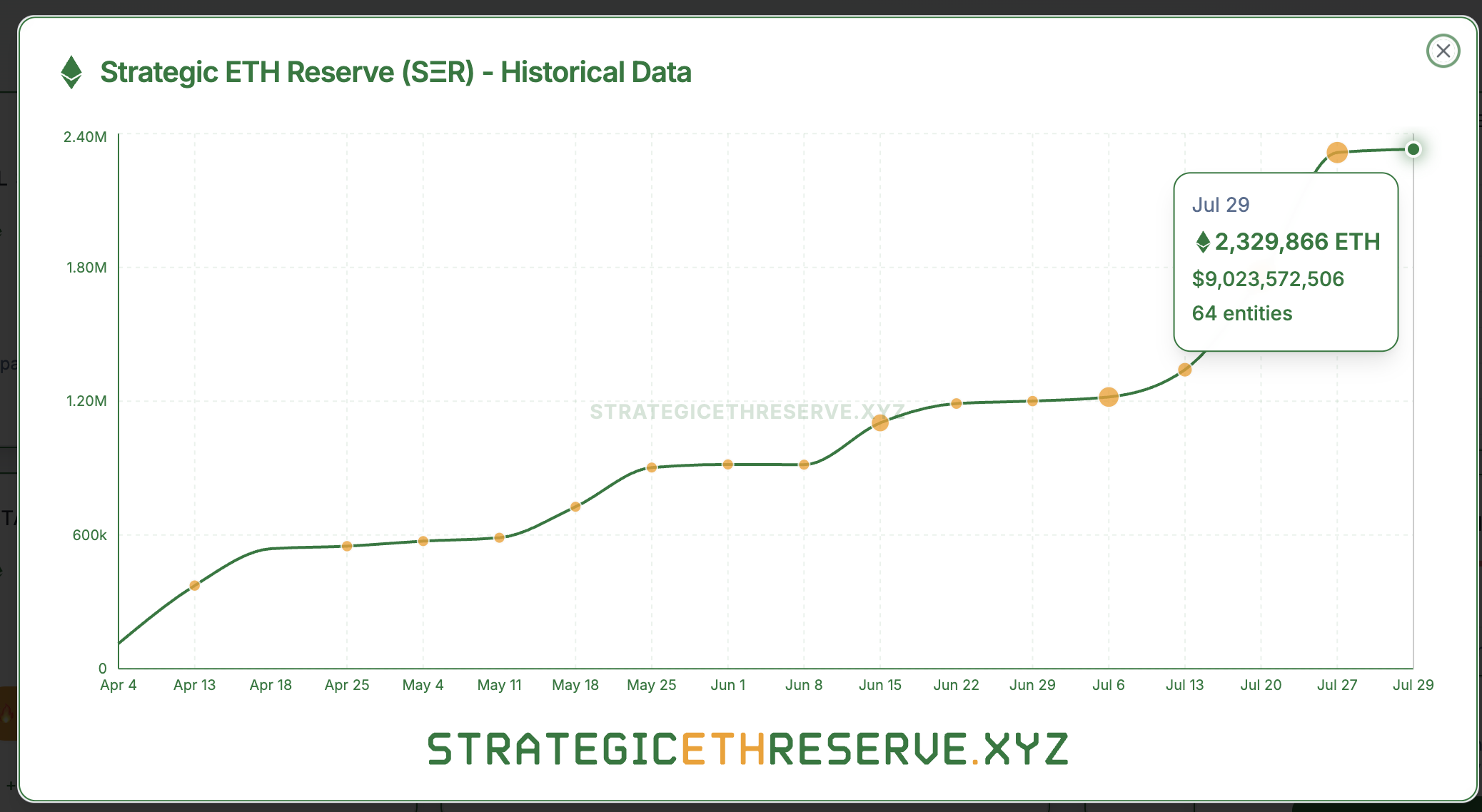
ETH reserve treasury company holdings.
As for the aforementioned crypto institutions, whether actively or passively, they have gradually begun to exit the ranks of ETH big players: Galaxy transferred 65,600 ETH (valued at about $10.5 million) to Binance within two weeks in April 2024; just on July 28, HashKey Capital's associated wallet transferred 12,000 ETH (valued at about $4.718 million) to OKX; Arkham data shows that the Paradigm institutional address has seen its ETH holdings drop sharply from 83,500 ETH in April this year to just over 2,800 ETH now; the Dragonfly institutional address has even more limited holdings, with only about 155 ETH. Although it is highly likely that various institutions still hold some ETH assets in exchanges, DeFi protocols, or cold wallets, the apparent “withdrawal” has already become a settled matter.
At this point, perhaps we can only sigh: “New talents emerge in every generation, replacing the old.”
The Narrative Evolution of Ethereum: From World Computer to World Ledger, and Now to Digital Oil
Having discussed the process of changing hands, the narrative evolution of Ethereum may seem somewhat barren.
Technology, Applications, and Resources: From One Person's Vision to Ecological Growth
In the vision of Ethereum founder Vitalik, Ethereum was to serve as a “world computer” to build a rich on-chain ecological foundation, thereby creating a more transparent and decentralized on-chain world based on the digital space of the internet. This can be seen from the YouTube video “Ethereum: The World Computer” released by the Ethereum Foundation on July 30, 2015. At that time, Ethereum's core advantage and market selling point was that developers could use smart contracts to build decentralized applications, whether they were games, social networks, or financial products.
However, as time passed, although games like CryptoKitties, Axie Infinity, and STEPN once sparked a phenomenal crypto craze; and although NFTs like Cryptopunks, BAYC, and Azuki once ignited a crypto bull market, to this day, only DeFi has remained resilient in the crypto market, and to some extent, it can even be said to be the “only survivor” in the field. It is no wonder that previously, DeFinance Capital founder Arthur believed that Ethereum's market value did not match its industry status due to Vitalik's willingness to speculate on DeFi. Thus, Ethereum's narrative has factually shifted to that of a “world ledger.”
Subsequently, although the market and even the Ethereum community once regarded “ultrasound money” as Ethereum's new value narrative, this narrative has not gained widespread recognition in terms of dissemination, acceptance, or “market dream rate.”
It wasn't until the emergence of EIP-1599 that the deflationary properties of ETH gradually became prominent. Thus, as cryptocurrencies gradually transformed into digital assets that mainstream society could accept and recognize, ETH gradually became a “fuel” driving the development of the digital economy, akin to oil.
In an important dissemination platform for the Ethereum ecosystem—the Bankless podcast “Ethereum is Digital Oil”—ETH is viewed as “digital oil,” emphasizing its value as network fuel and a reserve asset. ICBC (Industrial and Commercial Bank of China) previously compared ETH with BTC, known as “digital gold,” calling it “digital oil” in a report.
In the future, if ETH wants to stimulate the sensitive and fragile investment nerves of more people, it may need to strengthen its narrative positioning as “digital oil.” At that time, Ethereum could transform into something as unbreakable as the current U.S. dollar system.
What is the Price Ceiling for Ethereum? Possibly $706,000
Regarding the price ceiling of Ethereum, market opinions are more diverse.
In June 2024, just before the approval of the Ethereum spot ETF, asset management company VanEck predicted that the target price for Ethereum will reach $22,000 by 2030. This prediction is influenced by news regarding the Ethereum ETF, progress in scaling, and on-chain data. VanEck pointed out that Ethereum is reshaping multiple industries, including finance, banking, payments, marketing, advertising, social media, gaming, infrastructure, and artificial intelligence. Additionally, VanEck predicts that the size of the Ethereum (spot) ETF could surpass that of the Bitcoin ETF and expects this ETF to be approved for listing, providing a convenient way for financial advisors and institutional investors to hold Ethereum. The report also emphasizes that the low cost, high efficiency, and transparency of Ethereum technology are key factors driving the increase in Ethereum's price.
VanEck further predicts that this shift will force traditional financial and tech institutions to transfer a significant market share to blockchain-based solutions, with these institutions currently holding up to $15 trillion in total addressable market. By 2030, the free cash flow generated from holding Ethereum is expected to reach $66 billion, which will also help propel Ethereum's valuation towards the anticipated target.
This year, for publicly traded companies implementing the Ethereum reserve treasury strategy, a price of just $22,000 is already considered significantly undervalued.
The cryptocurrency mining company Bitmine officially stated that it has invited several research institutions to assess Ethereum's "reset value" (Wall Street valuation), estimating it to be $60,000. Supporting this argument is a previous statement by U.S. Treasury Secretary Janet Yellen, indicating that the market capitalization of stablecoins is expected to reach $4 trillion, growing more than tenfold, with over 60% of stablecoins currently on the Ethereum network.
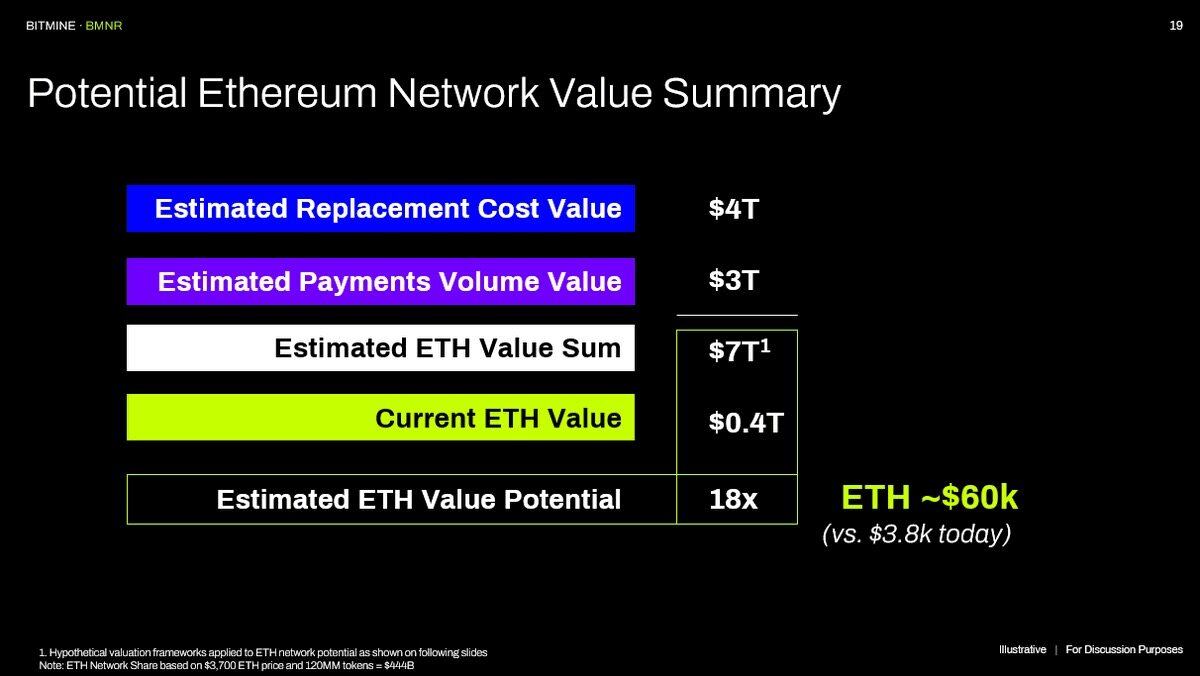
ETH at $60,000 each
Ethdigitaloil.com is even bolder, suggesting that considering oil, gold, and the global currency market capitalization, the market cap of ETH could reach $85 trillion, with the future price of a single ETH expected to reach $706,000.
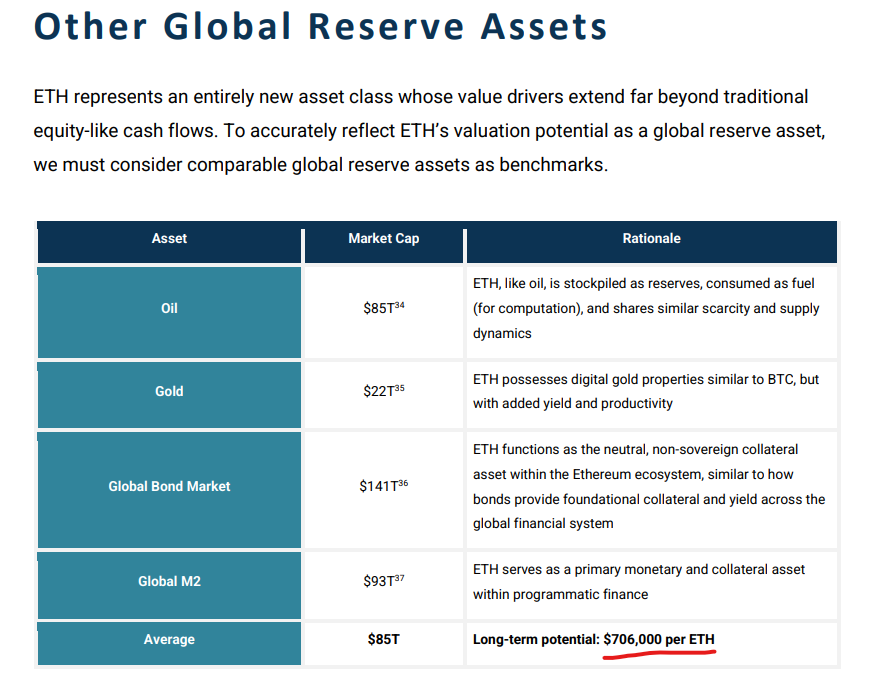
ETH price ceiling
Of course, if such a price is truly achievable, it may require waiting for Ethereum's "centennial moment."
Currently, Ethereum has only completed one-tenth of its journey, with 90 years remaining until it reaches the status of a "century-old store."
By then, Vitalik, who is now over thirty, will have become a centenarian. In a future with advanced biotechnology, he may still be a witness to Ethereum's history, just like you and me.
Recommended Reading
Five Charts Reviewing Ethereum's History
ETH Staking Data and Corresponding Platform Dune Charts
The Last Miners: A Comprehensive Review of Eight Years of Ethereum Mining History
Galaxy: Analysis Report on ETH Supply Distribution Since Genesis
Revealing the Two Key Figures Behind the Recent Surge in ETH: Tom Lee vs. Joseph Rubin
免责声明:本文章仅代表作者个人观点,不代表本平台的立场和观点。本文章仅供信息分享,不构成对任何人的任何投资建议。用户与作者之间的任何争议,与本平台无关。如网页中刊载的文章或图片涉及侵权,请提供相关的权利证明和身份证明发送邮件到support@aicoin.com,本平台相关工作人员将会进行核查。




